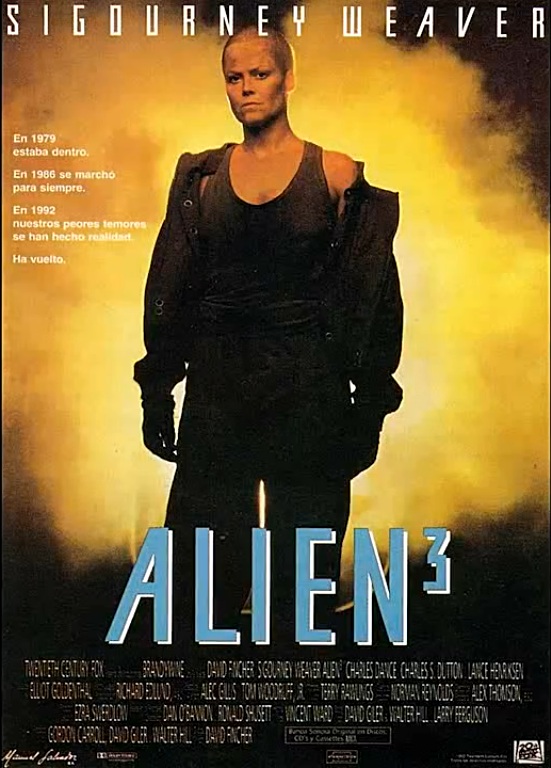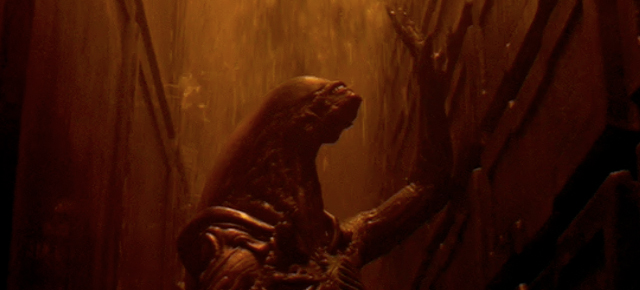SPOILER WARNING:
Alien3 (1992):
Now we come to the second of my “deviant” rankings. Just as I rank the original Predator rather lower than do most fans, I also rank Alien3 rather higher.

Let me begin by acknowledging that most of the standard fan complaints about A3 are quite legitimate. A3 takes the previous movie and stabs it in the gut – which, if you like Aliens (and you should), is distressing. Ripley’s victory at the end of Aliens is undercut when everyone she managed to save in the last movie, including her daughter surrogate, is killed off in the opening moments of A3 (thereby incidentally ejecting from the canon the intervening comics series detailing the adventures of the adult Newt) – and the triumphant ending of Aliens is replaced with a mood of bleak despair which sets in at the beginning of A3 and never really relents.
(How did the eggs get on the ship anyway? We can suppose that the xeno-queen laid them at the end of Aliens, but it doesn’t seem ever to have left the cargo bay, so how did its eggs end up so close to the cryotubes? And after everything that’s happened, wouldn’t Ripley have done a more careful search before bedding down?)
Moreover, in A3 Ripley’s character seems weakened in various ways. We learn that Ripley, who has heroically resisted alien penetration for the past two films, has been violated in her sleep and impregnated by a xenomorph, and thus is now also doomed to die; and she spends much of the film trying to get others to kill her before the “birth” does, because she lacks the courage to commit suicide. She is plunged into a misogynistic atmosphere and is on the verge of being gang-raped by several of the prisoners, and has to be rescued by a man. (It might have been more interesting if she’d been rescued by the xenomorph, protecting the bearer of the queen.) She has to share the screen with two compelling male characters (Clemens and Dillon) whose moral authority rivals hers. At one point she is offered leadership over the group, but makes no response, just sitting there listlessly, and someone else has to come up with the idea of luring the xenomorph into the furnace. And then Ripley dies at the end – which might seem like the ultimate defeat. Moreover, the fact that this is the first film in which she has sex (a sex scene between Ripley and Dallas was scripted for Alien but not shot; the relationship between Ripley and Hicks in Aliens becomes semi-flirtatious but never has time to develop), combined with her death at the end, raises the concern that she’s being made an instance of the misogynistic “Death by Sex” trope.
To these disadvantages of A3 we can add that an alien threat that refuses to harm the protagonist is not exactly going to make for the scariest entry in the series.
So yes, I grant the legitimacy of all these charges against A3. But that’s not the end of the story. So let me state my case for the film.

It’s always something
First, one of the positives of the Alien series is that unlike some series – I’m looking at you, Rocky, Rambo, Lethal Weapon, Friday the 13th, Die Hard, Fast and Furious, etc. – each film is thematically and tonally different from all the others. A3 could have been a jacked-up reprise of Aliens, with Ripley blowing away hordes of xenomorphs, but we already have Aliens; why not take the opportunity to do something different?
Second, recall that Aliens’ feminist credentials came at the cost of a feminist demerit: reinforcing the myth that courage, strength, and self-assertion in a woman are made possible and/or permissible only by the context, and in the service, of woman’s “natural role” of motherhood. In that respect, despite A3’s many feminist demerits, it gloriously subverts the previous film’s motherhood trope.
In A3, Ripley’s heroic struggle is a struggle not to reproduce, not to become a mother. Both the Weyland-Yutani company and the xenomorph regard Ripley as a mere shell or container for her potential offspring; they both value her highly, but only as a means of nurturance for the fetus inside her. As far as Ripley as a person in her own right is concerned, the company regards her as, in Ripley’s own words, “crud,” along with the prisoners the company has abandoned at the “ass-end of space.” But Ripley is willing to die rather than serve as an incubator for an unwanted fetus.

Possibly the brownest movie ever made
In short, Ripley’s position vis-à-vis both Weyland-Yutani and the xenomorph is quite strictly that of an unwillingly pregnant woman vis-à-vis the anti-abortion forces in society. A3 is a dramatisation of the pro-choice position.
(I remember that when the film first came out, a number of reviewers treated Ripley’s condition as a metaphor for AIDS, a far less precise analogy, and that nobody was making what seemed to me the obvious connection with the abortion issue. A quick google search on the keywords “Alien3” and “abortion” reveals that while the connection is made more often today – most recently at Daily Kos, of all places – it’s still not all that common, and in fact many of the results were simply people calling the film itself an abortion.)
Some will object, no doubt, that insofar as A3 is a pro-choice fable, it distorts the natural relationship of pregnancy; John Wilcox, analogously, has criticised Thomson-style defenses of abortion for treating “nature as demonic.” But nature in the merely biological sense is demonic when it threatens nature in the sense of full autonomous personhood – and social institutions are likewise demonic when they side with biology against personhood. As I have written elsewhere:
Opponents of the right to abortion find [Thomson-style arguments] repellent. How, they ask, can one treat a fetus as some sort of alien parasite, and pregnancy as a unnatural violation, when pregnancy is the most natural thing in the world? Well, sexual intercourse is also the most “natural” thing in the world; but when it is involuntary, it becomes rape. Likewise, when the “natural” process of pregnancy is involuntary, it too becomes an alien intrusion or violation.
Ripley’s suicide is no self-sacrifice, except in the merely biological sense; defying both the corporate/governmental forces outside her and the demonic nature within her, Ripley sacrifices herself-as-meat in order to honour herself-as-person. Ripley’s death is a victory (albeit under constrained circumstances), not a defeat.

Dillon and the Dead
The fact that the prisoners are described as double-Y chromosome cases, implying a genetic predisposition to aggression, raises a broader theme about whether biology is destiny – one that the redemption of (many of) the prisoners answers in the negative as much as does Ripley’s refusal of the reproductive role. (Incidentally it’s unclear whether Clemens is likewise supposed to be a double-Y case. His homicides were inadvertent rather than acts of deliberate violence, so it’s a bit odd that he was originally sent to this facility, and for a seven-year term, when the other inmates are described as incorrigibly violent, and as “lifers.” But then we never actually find out whether Clemens is telling the truth, though I’m inclined to think so.)
One might argue that Ripley is still filling a nurturing role, in that she is acting to protect the human race from the danger of xenomorph proliferation (no pun intended); but refusing to contribute to genocide seems more a matter of justice and integrity than of maternal care.
Nor do I think she is as effaced and defeated in the film as critics suggest. Yes, she has to share the screen with two powerful male personalities whose moral authority rivals hers; but, like Hicks, both acknowledge and reinforce her authority by granting her respect – Clemens immediately and willingly, Dillon later and grudgingly. (And Morse and Aaron still later and even more grudgingly.) Yes, she fails to accept, or even respond to, the offer of leadership; but the fact that it is even made, by the very same men who were previously mocking or threatening her, is another acknowledging of her authority. And Ripley holds her own against Dillon; when he warns her not to sit at his table because he is a “murderer and rapist of women,” she says something like “then I guess I must make you uncomfortable,” and sits down anyway. (It must be said that Dillon reacts better to her doing so than Ripley did to Bishop’s presence at her table in the previous movie.)
Dillon, A3’s major black character, shares a name in common with Predator’s main black character; this may be a coincidence, but there are a couple of other similarities as well: each Dillon is the protagonist’s chief rival for authority, their relationship is somewhat hostile for a while before becoming more positive, and each Dillon dies semi-voluntarily in an effort to protect others. (That said, A3’s Dillon is obviously a much cooler character.)
The needle and the damage done
The interplay between Ripley & Clemens – the mutual trust, despite mutual wariness – is also nicely handled: his readily supporting her cholera story, her readily offering him her arm for his needle despite the account he’s just given her of having accidentally killed eleven patients by giving them the wrong injections (this last is a bit reminiscent of the story of Alexander of Macedon’s proving his trust for his physician by willingly drinking his medicine despite having just been warned to distrust the physician as a poisoner; there’s a similar scene toward the end of The Fountainhead, when Roark signs Wynand’s contract without reading it). Of course it doesn’t hurt to have Charles Dance – with his usual grace, subtlety, and riveting presence – in the role.
Back in Part 1, I described A3 as one of the three most beautiful films in the series, while noting that many fans regard it as the ugliest. I understand the latter judgment: the dominant colour is brown, the dominant mood is bleak, and most of the prisoners are filmed in such a way as to make them look as ugly as possible. But to me the rich brown colour of the film (maybe it’ll sound more artistic if we call it sepia) is reminiscent of the artwork of Rembrandt and Hugo, while the camera’s lovingly dwelling on the lit-to-seem-grotesque contours of the prisoners’ faces reminds me of Leonardo’s sketches. Take a look at some of these images and see if you don’t find them akin to the intensely atmospheric all-pervading brownness of the film:

Da Vinci – Sketches

Rembrandt – The Philosopher

Rembrandt – Self-Portrait

Hugo – The Gibbet

Hugo – The Tower
Incidentally, you don’t want to know what Hugo used to achieve his brown tints. (Notice how, by saying that, I simultaneously cause you to want to know – thus making the sentence false when it would have remained true if left unuttered – and cause you to know, thus satisfying the desire in the very act of stimulating it. How to do things with words, eh?)

Why yes, we’re Browncoats
A few other points:
We’re told that Dillon’s religion is a Christian one, but it doesn’t seem to have much doctrinal content. But then faith tends to be fairly contentless in Hollywood movies; the problem will be much worse in Prometheus.
A3 is the first film to establish that the appearance of the xenomorph is affected by that of the organism it gestates in – a fact which will later be exploited (if a murky shape in mostly impenetrable darkness counts as successful exploitation) in Aliens vs. Predator: Requiem.
In related news, Ripley’s xenobaby seems to have a far longer gestation than any we’ve previously seen – but perhaps that’s because queens are different.
The scene where Ripley mistakes a pipe for the xenomorph is presumably a nod to the scene near the end of Alien where she mistakes the xenomorph for a pipe. (Though in keeping with A3’s lower fright level, this is obviously a less scary mistake to make.)
Why is the term “robot” in the first movie replaced by “android” in the second, and “droid” here? We might chalk it up to changes of usage during the years between Ripley’s hypersleeps, but the time gap between Aliens and A3 doesn’t seem as long as the previous one, and moreover Ripley herself shifts her usage along with everyone else, without apparent prompting.
The differences between the theatrical and special editions of A3 are the most dramatic for any in the series:
In the theatrical version, Ripley is found, still in her cryotube, in the crashed escape pod; in the special edition, she’s found lying on the beach by Clemens, in a hauntingly, bleakly beautiful opening scene whose deletion is a mystery. In the theatrical version, the xenomorph gestates inside a dog; in the special edition, it gestates inside an ox (yet, in an unfortunate continuity glitch, the first prisoner to encounter the xenomorph still calls out to it, mistaking it for the missing dog, even though no dog has been established as missing in this version).

The restored opening
Paul McGann’s character, Golic, plays a larger role in the special edition. For Doctor Who fans it’s ironic enough to see McGann in the theatrical version, since this is precisely the kind of situation – a base under siege, run by an arrogant, closed-minded administrator – that the Doctor tends to show up in; but he’s not exactly his usual helpful self here. He’s even less helpful in the special edition, where he releases the xenomorph after the other convicts actually manage to trap it. Golic calls the xenomorph a “dragon,” and appears to worship it – which, given his prior Christian commitments, amounts to falling into Satan worship. Needless to say, this is not what the Doctor is supposed to do when he meets Satan.

There’s a dead Bishop on the landing!
In the special edition, when the human Bishop gets shot he exclaims, apparently to himself rather than to Ripley, “I’m not a droid!” – as though he’s surprised to learn that he’s been telling Ripley the truth. Has he never seen his own blood before? (Of course his not being an android gets retconned when we meet the original Bishop prototype in AVP, assuming that’s to be treated as canonical.) Also, as Ripley dives into the furnace, the xenobaby no longer bursts from her chest. I assume the suits insisted on a chestburster scene to satisfy presumed audience demands; but the scene is far better without it, for several reasons. It gives Ripley a more dignified (and certainly less painful) death; it enables her to avoid at least more of what she’s spent the whole movie trying to avoid; and it allows her to present a more Christ-like silhouette as she falls. Moreover, it makes Ripley’s sacrifice more meaningful; if the queen had really been that close to coming out, then the human(?) Bishop wouldn’t have had time to get Ripley to the operating room anyway, and so she would have lost nothing in turning down his offer. The decision surely caries more weight if the forgone alternative is a genuine possibility. (For similar reasons, I think it would have been better had it been left ambiguous whether Bishop is lying or not; we would still presume that he probably is, but the possibility that he might be telling the truth would make Ripley’s decision riskier and thus more courageous.)

Falling toward apotheosis
On the dvd the sound quality is poor in some of the restored scenes; I gather that this has been cleaned up on the blu-ray, but I don’t (yet) blu-ray.
Alien: Resurrection (1997):
And now we pass from the five movies I’d seen when they first came out to the five movies I’ve just seen for the first time in the past two months.

Just as Alien3’s reputation suffers thanks to its radical tonal difference from Aliens, so likewise Alien: Resurrection’s reputation suffers thanks to its radical tonal difference from Alien3. Unfortunately, here the similarity ends. When viewed as films in their own right rather than as continuations of a franchise, A3 does very well, while Resurrection falters and flails.
One problem is the villains. I’m all for depictions of governmental perfidy, but the malefactors here are so blatantly, maniacally, cartoonishly, over-the-top evil that there’s no nuance to them at all. The three main bad guys – Perez, Gediman, and Wren – seem to be playing their roles for laughs, constantly popping their eyes for no clear reason. It’s been rumoured that Whedon wrote the script as a comedy and the director ruined it by having the actors play it straight, but I find it hard to reconcile this diagnosis with the villains’ behaviour, since the actors seem, in an exact reversal, to be trying to milk laughs out of lines and scenes that offer none. After the depth and seriousness of A3, these panto antics are unbearable.
Giger’s original design
Another problem is the hybrid – the creature that arises from the blending of Ripley’s and the xeno-queen’s DNA. H.R. Giger’s original designs for Alien gave us a sleek, eerily menacing creature that danced on the knife edge between seductive and repellent; the hybrid is just butt-ugly. (Giger sued for not being credited in the film; if I’d been Giger I’d sooner have sued for being credited.) The film picks up the rejection-of-motherhood trope from A3, as Ripley is required to kill her own “offspring”; but we didn’t particularly need that story told again, and less well.

The hybrid – a face only a mother could love/kill
The film does have a few saving graces. One, of course, is, as always, Ripley herself. The way that Ripley is brought back, with memories more or less intact, is clever, and the idea that she now has a bit of xenomorph in her and vice versa is clever too, and enables Weaver to play the most badass, edgy, self-confident version of Ripley we’ve yet seen.
Another saving grace is admittedly more potential than actual: the crew of the Betty is clearly Whedon’s first draft of the crew of the Serenity. Johner in particular is essentially the same person as Jayne, though the other characters are more mix-and-match. Alas, the ascent from the first crew to the later one is steep; the Betty crew’s dialogue doesn’t sparkle the way the dialogue in Firefly does, and apart from Call they’re less sympathetic as characters (partly because they lack the failed-rebellion backstory, and partly because they’re even less morally fastidious as to what missions they’ll accept). Still, this is the closest we’ll ever get to Alien vs. Firefly.

ALIEN: RESURRECTION’s three clownish villains
There are some striking scenes: the scientists using pain buttons to “train” the xenomorphs; the way the xenomorphs escape; Ripley finding her previous clones. And in what is otherwise the least visually appealing of the Alien films, the underwater scene is pretty.
There’s also a nice slap against the left-conflationist/vulgar-liberal/left-cop-right-cop/Chomskyesque assumption that state power is more trustworthy than state-enabled business power: at one point Ripley is told something like “oh, you don’t have to worry now – it’s not the greedy Weyland-Yutani corporation running this project any more; now it’s the government and the military, so everything’s changed.” Ripley says, “I doubt it.”
The complicity of scientists in the military-industrial complex is also highlighted. It’s long been a common sf trope for scientists to insist on studying and/or seeking peaceful communication with a potential alien threat, and to dismiss worries that doing so is too risky, while the military are conversely eager to blow the aliens to bits; see, for example, the original (1951) versions of The Day the Earth Stood Still and The Thing From Another World (two films that pick opposite sides in that dispute). But here scientists and the military are allied in seeking to study the aliens in order to blow others to bits, and they are alike dismissive of concerns about risks; this is unfortunately a more accurate depiction of the usual relation between science and government. (If only unethical scientists always had bulging eyes and insane grimaces like the ones in this movie! It’d make them easier to spot.)

Do androids dream of electric sheep that burst out of people’s chests?
Androids have been undergoing some changes during Ripley’s snoozes. Back in Alien (and still farther “back” in Prometheus, evidently), androids could be ordered to harm humans. (Bishop blames Ash’s actions on a malfunction, but only on the basis of Burke’s underdescription of what happened; we have no reason to think Ash was doing anything but following orders.) Then by Bishop’s day, androids were programmed with Asimovian inhibitions. Now, apparently, androids (or some of them) have achieved free will, and are subject to neither sort of command, though such androids are likewise hunted down (by blade runners?). (Incidentally, a sign of Ripley’s – well, “Ripley’s” – character arc, and admittedly of the general shittiness of her life story, is that she goes from distrusting Bishop because he’s an android to declaring Call trustworthy because she’s not human.)

Please mess with Ripley
The special edition differs from the theatrical version most dramatically in its beginning and its ending (though it also has a bit more Ripley character material). The special edition opens with a close-up on what is apparently a snarling xenomorph’s jaws; then the camera pulls back to show that it is actually an ordinary-sized housefly (or some similar insect) with some xenomorph features. So is this supposed to be an accidental byproduct of the experiments depicted in the movie? We’re never told. Pulling farther back, we see a human worker squishing the fly and then flicking it against a window, where it goes splat. At this point anyone who’s seen the previous movies expects the fly’s acidic blood to melt a hole in the window – with catastrophic results, since it quickly becomes clear that this window is on a spaceship. That would also be a nice foreshadowing of the hybrid’s fate later in the film. But no, nothing happens – it’s just a dead bug. And the next scene is the cloning lab that was the first scene of the theatrical version. So what was the point? After the atmospheric beginnings of the first three Alien movies, this pointless triviality is especially disappointing.
The ending scene, by contrast, is improved in the special edition. In the theatrical version, the Betty is landing on Earth, and Call looks out the window and declares with surprise that it’s beautiful (which is indeed a bit of a surprise, since Johner has told us earlier that Earth is a “shithole”), but we never see anything. In the special edition, by contrast, the Betty lands on a devastated nuclear landscape that was once Paris, and nobody declares anything beautiful – which seems more appropriate. (You can see the special-edition beginning and ending here and here; embedding disabled, alas.)
Next: Alien vs. Predator and Aliens vs. Predator: Requiem.

